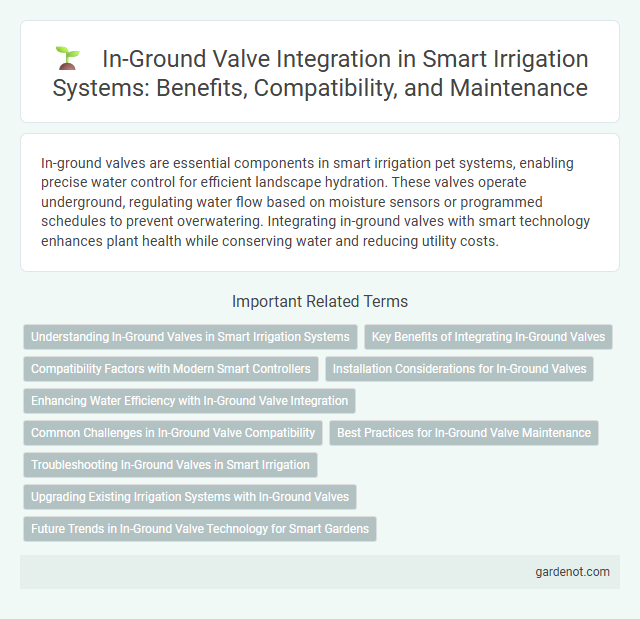In-ground valves are essential components in smart irrigation pet systems, enabling precise water control for efficient landscape hydration. These valves operate underground, regulating water flow based on moisture sensors or programmed schedules to prevent overwatering. Integrating in-ground valves with smart technology enhances plant health while conserving water and reducing utility costs.
Understanding In-Ground Valves in Smart Irrigation Systems
In-ground valves are crucial components in smart irrigation systems, controlling water flow directly at the source to various irrigation zones. These electrically operated valves integrate with smart controllers and soil moisture sensors for precise, automated watering schedules that optimize water efficiency and promote healthy plant growth. Understanding in-ground valve operation and compatibility with smart systems ensures effective irrigation management and reduces water waste.
Key Benefits of Integrating In-Ground Valves
In-ground valves enhance smart irrigation systems by offering precise water control directly at each zone, reducing water waste and improving overall efficiency. Their integration supports automated scheduling and remote management, enabling tailored watering based on real-time soil moisture data. This leads to healthier landscapes, energy savings, and lower water bills through optimized irrigation practices.
Compatibility Factors with Modern Smart Controllers
In-ground valves must be compatible with modern smart controllers through factors such as voltage requirements, typically 24V AC, and connector types like common screw terminals or quick-connect plugs. The valve's flow rate and pressure ratings should align with the controller's specifications to ensure efficient water delivery and system responsiveness. Integration also depends on communication protocols supported by smart irrigation controllers, including wireless signals or proprietary interfaces for seamless automation.
Installation Considerations for In-Ground Valves
Proper installation of in-ground valves requires selecting a location that ensures easy access for maintenance and protection from physical damage. It is essential to bury the valve box at a depth that prevents freezing in colder climates and provides adequate drainage to avoid water accumulation. Use compatible pipe fittings and ensure tight connections to prevent leaks and optimize irrigation system performance.
Enhancing Water Efficiency with In-Ground Valve Integration
Integrating in-ground valves in smart irrigation systems enhances water efficiency by precisely controlling water flow to targeted zones, minimizing runoff and evaporation. These valves allow automated scheduling based on real-time soil moisture data, reducing water waste and promoting healthier plant growth. Advanced in-ground valve technology supports remote management and leak detection, optimizing irrigation performance and conserving resources.
Common Challenges in In-Ground Valve Compatibility
In-ground valve compatibility often faces challenges such as inconsistent valve sizing, leading to improper fitment with irrigation controllers and pipes. Many valves lack standardized thread dimensions, causing leaks and reduced system efficiency. Materials used in valves can also differ, affecting durability and compatibility with various soil types and environmental conditions.
Best Practices for In-Ground Valve Maintenance
Regular inspection and cleaning of in-ground valves prevent debris buildup that can cause malfunctions in smart irrigation systems. Using quality valve boxes and ensuring proper drainage extends valve lifespan by protecting against moisture and root intrusion. Routine testing and calibration help maintain optimal water flow, improving irrigation efficiency and conserving resources.
Troubleshooting In-Ground Valves in Smart Irrigation
Troubleshooting in-ground valves in smart irrigation systems involves checking for electrical connectivity issues, such as faulty solenoid coils or damaged wiring, which can prevent valve activation. Leaks or blockages within the valve itself may cause improper water flow, requiring inspection and cleaning or replacement of diaphragm components. Ensuring proper valve calibration and communication with the irrigation controller is critical for maintaining precise water delivery and system efficiency.
Upgrading Existing Irrigation Systems with In-Ground Valves
Upgrading existing irrigation systems with in-ground valves enhances water efficiency by providing precise zonal control and reducing runoff. Modern in-ground valves integrate with smart irrigation controllers, allowing automated scheduling based on real-time soil moisture and weather data. Retrofitting existing setups with durable, weather-resistant valves ensures long-term system reliability and minimizes maintenance needs.
Future Trends in In-Ground Valve Technology for Smart Gardens
Future trends in in-ground valve technology for smart gardens emphasize advanced sensor integration and wireless communication, enabling precise water flow control based on real-time soil moisture and weather data. AI-driven valve systems are being developed to optimize irrigation schedules, reducing water waste and enhancing plant health. Emerging innovations also include energy-efficient actuators and self-diagnosing valves that improve system reliability and maintenance efficiency.
In-ground valve Infographic

 gardenot.com
gardenot.com